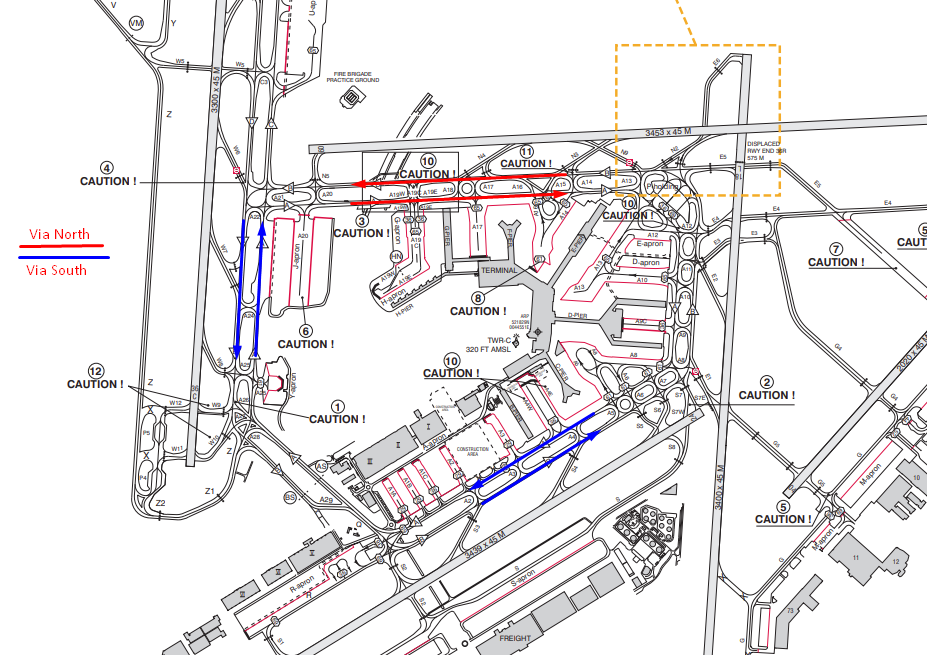Pilot Resources
Overview. Schiphol's procedures are quite unique. Pilots should avoid operating out of Schiphol without reading this document.
Runway Use. Pilots and ATC should follow real world runway usage, available here: https://en.lvnl.nl/environment/runway-use.
Transponder. Switch transponder to ON, XPNDR or AUTO mode before moving and switch it to STANDBY or OFF when stopped at the gate.
Common errors. The following errors have been recognized as common errors made by pilots on Schiphol:
- Flying a different SID then assigned, for example flying a night SID on day time.
- Taxiing the wrong way on taxiways A, B, C or D. Remember to keep the other taxiway on your left.
- Failure to automatically contact the appropiate departure frequency when passing 2000ft.
- Failure to automatically contact SCHIPHOL Ground after vacating landing runway.
Hotspots. Schiphol has quite a few hotspots scattered over the airfield. They are listed below:
- Do not mistake taxiway D for runway 18C.
- When taxiing to holdingpoint E6, runway 18L, turn left onto E6 instead of right onto runway 09/27. Be sure to have crossing clearence.
- After landing on runway 36R do not cross the red lights inidcating displaced runway end 36R, no light available beyond the displayed runway end 36R.
- Taxiway G1 is located directly opposite apron exit GD. Hold short of runway 22 unless instructed otherwise by Tower.
Scenery. There are multiple add-on sceneries available for Amsterdam Airport Schiphol. If using FSX or P3D, we strongly recommend you download an addon scenery to include the latest developments on the airfield. If you do not have downloaded an addon scenery, be sure to follow the taxi diagrams instead of the the taxiway signs in the simulator.
FSX/P3D Approved:
- FlyTampa Amsterdam (Payware)
- NL2000 Amsterdam (Freeware)
X-Plane 11 Approved:
- FlyTampa Amsterdam (Payware (In development))
- Aerosoft Amsterdam
Uncontrolled Operations. The following frequencies should be utilized only when POSCON ATC is offline:
ATIS (Currently Offline):
- Schiphol Departure Information: 122.205
- Schiphol Arrival Information: 132.980
CTAF:
- 122.950
Gate Assignment:
Shengen/Non-Shengen. On Schiphol, the airport security is split in two. Shengen and Non-Shengen. So when you arrive from a Shengen country, you will park at a shengen stand or a mixed stand. On a mixed stand both Shengen and Non-Shengen arrivals can be parked.
Shengen countries:
BI, EB, ED, EE, EF, EH, EK, EL, EN, EP, ES, EV, EY, GC, LE, LF, LG, LH, LI, LJ, LK, LM, LO, LS, LZ
Shengen stands:
- A pier
- B per
- C pier
- D2-D12
- D41-D57
- H pier
Non-Shengen stands:
- D pier
- E pier
- F pier
- H pier
Stands that appear in both lists are mixed stands.
A380. The A380 has two gates it is allowed to park on. Those gates are G9 and E18. Emirates Airline/UAE parks at G9 and China Southern/CSN parks at E18.
Taxi Procedures:
Standard calls. There are two standard calls made by the ground controller. These are 'TAXI VIA NORTH' and 'TAXI VIA SOUTH'. The routes are as displayed in the chart below: 
| TAXI VIA NORTH | TAXI VIA SOUTH | |
|---|---|---|
| INBOUND | Taxiway A via the northside of the airport | Taxiway B and Q via the southside of the airport |
| OUTBOUND | Taxiway B via the northside of the airport | Taxiway A and Q via the southside of the airport |
CPDLC Logon. EHAA
Initial Climb. Usually FL60. SCHIPHOL Delivery will confirm the Initial Climb in the clearence. When it is above 3000ft (the Transition Altitude), you have to read it back as a flight level.
'Report Ready'. When you read the clearence back correctly, SCHIPHOL Delivery will send you to the SCHIPHOL Planner Controller (121.655) if active. If there is no SCHIPHOL Planner Controller, SCHIPHOL Delivery keep you on their frequency. When you are fully ready (Pushback Connected, doors closed, APU running) and within 5 minutes of your TSAT window. Your 'Fully Ready'-report has to include Aircraft Identification, Parking Position, Received ATIS and 'READY'. SCHIPHOL Planner will then report the QNH, Current ATIS Information and the correct ground frequency to you. When that happens you shall directly contact SCHIPHOL Ground on that frequency for pushback.
Taxi procedures. Taxiway direction on taxiway A is clockwise. Taxiway direction on taxiway B is counter-clockwise. Taxiway D is southbound. Taxiway C is northbound. At ramps with multiple taxiways going in enter in a clockwise direction, as following:
| Apron entry | Apron exit |
|---|---|
| A5 | A6, A7, A8 |
| A10 | A12, A13 |
| A14 | A15, A16 |
SCHIPHOL Departure. Contact SCHIPHOL Departure by yourself when passing 2000ft.
-
119.055 is for the following SID points:
- ANDIK
- ARNEM
- EDUPO
- IVLUT
- KUDAD
- LARAS
- LOPIK
- NOPSU
- NYKER
- OGINA
- RENDI
- ROVEN
- TORGA
- WOODY
-
121.205 is for the following SID points:
- BERGI
- BETUS
- DENAG
- IDRID
- SPY
- VALKO
- VOLLA
- WISPA
Transfer to ACC.
Transfer to the ACC/Stack Controller takes place after intial descend clearence has been issued and the aircraft is clear of en-route traffic.
They will issue further descend instructions.
Arrival Clearence. When transferred to Amsterdam ACC(Amsterdam Radar), initial contact is restricted to AMSTERDAM RADAR + Callsign. At, or before, entering the Amsterdam Control Area, an arrival clearence will be issued containing:
- Standard Arrival Route or direct route
- Expected landing runway
- Level inctructions
- Any other necessary instructions or information
Speed and level restrictions:
| Arrival | Position | Level restriction |
|---|---|---|
| DENUT 3A | DENUT | MAX FL 240 |
| EEL 1A | 15 NM before EEL | MAX FL 260 |
| EEL 1B 1) (ATC discretion) | ||
| HELEN 2A | HELEN | MAX FL 240 |
| LAMSO 2A | LAMSO | MAX FL 230 |
| MOLIX 2A | MOLIX | MAX FL 230 |
| NORKU 2A | NORKU |
MNM FL 200 MAX FL 280 |
| NORKU 2B 1) (ATC discretion) | ||
| PESER 3A | PESER | MAX FL 070 |
| REDFA 1A | REDFA | MAX FL 230 |
| RKN 2A | RKN DME | MAX FL 180 |
| RKN 2B 1) (ATC discretion) | ||
| TOPPA 2A | TOPPA | MAX FL 250 |
|
||
Transfer to SCHIPHOL Approach. Inbound traffic via ARTIP is transferred to 119.055 and inbound traffic via RIVER and SUGOL is transferred to 121.205. Initial contact should only include SCHIPHOL APPROACH + CALLSIGN to avoid channel congestion. In some situations, Amsterdam Radar may request pilots to include additional information for SCHIPHOL Approach in the initial contact.
Initial Approach Clearance. The initial approach clearance shall include:
- Clearence limit and level instructions
- Runway in use
- Type of approach
- QNH
- Tranisition level
-
Runway Condition
(Items 2, 4, 5 and 6 will only be given when the ATIS is out of service)
Transfer to SCHIPHOL Arrival. Transfer to SCHIPHOL Arrival takes place before the aircraft enters the final approach vector area. The initial contact should only include SCHIPHOL ARRIVAL + CALLSIGN.
Transfer to SCHIPHOL Tower. Transfer to SCHIPHOL Tower happens when the aircraft is established on final approach. The initial contact shall consist of SCHIPHOL TOWER, CALLSIGN, RUNWAY.
Transfer to SCHIPHOL Ground. After vacating the runway contact SCHIPHOL Ground automatically on the following frequency:
- Landing on 04/22: 121.805
- Landing on 06/24: 121.705
- Landing on 09/27: 121.805
- Landing on 18C/36C: 121.905
- Landing on 18R: 121.560
- Landing on 36R: 121.805
Missed Approach Procedure.
- Inform ATC Immediately
- Unless otherwise instructed follow the standard missed approach procedure
K apron. K Apron is uncontrolled between GL and GD. Contact Schiphol Amsterdam General Aviation on frequency 121.930 for stand assignment. Nose-in parking is required. Pushback is required, facing GD.
IFR. IFR can expect runway 04 or 22 for departure and ILS runway 22 or LOC runway 36L with circle to land to runway 04 for landing. Airplanes departing runway 04 with a wide wingspan then 31 meters have to depart from G2.
VFR. Victor Arrival/Departure is required for all EHAM VFR traffic. Victor VFR route is at 1000ft, easily locatable by radio 307 inbound or 127 outbound of SPL VOR (108.4). EHAM has threshold crosswind and base.
